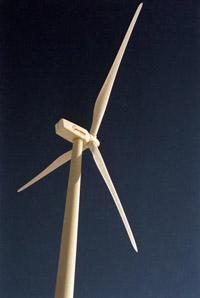The Fish and Wildlife Service and Wind Energy Development
 Advances in wind turbines technologies and increased interest in renewable energy sources have resulted in rapid expansion of the wind energy industry in the United States. Advances in wind turbines technologies and increased interest in renewable energy sources have resulted in rapid expansion of the wind energy industry in the United States.
The Fish and Wildlife Service's Project Planning Program typically becomes involved in the review of potential wind energy developments on public lands through the National Environmental Policy Act. This may be as a cooperating agency or because of the Service's responsibilities under the Migratory Bird Treaty Act, the Bald and Golden Eagle Protection Act, the Endangered Species Act, or because of the Agency's special technical expertise.
The Service established a Wind Turbine Siting Working Group in 2002, to develop a set of comprehensive national guidelines for siting and constructing wind energy facilities. The purpose of the guidelines was to help protect wildlife resources, streamline the site selection and design process, and to assist in avoiding post- construction environmental concerns.
In 2003, the Service published its Interim Guidelines to Avoid and Minimize Wildlife Impacts from Wind Turbines. The interim guidelines were produced with the best available science, with the understanding that they would be updated as new information becomes available. The guidelines were published simultaneously with a Federal Register Notice of Availability and request for comments on the guidelines.
After reviewing the comments received, the Secretary of the Interior established a Wind Turbine Guidelines Advisory Committee , composed of 22 members appointed by the Secretary to achieve balanced representation of wind energy development, wildlife conservation, and government. The Committee, formed in accordance with the Federal Advisory Committee Act, will provide advice and recommendations to the Secretary on developing effective measures to avoid or minimize impacts to wildlife and their habitats related to land-based wind energy facilities.
Wind Energy Facts
- Commercial wind energy plants have been constructed in 35 States, with approximately 11,575 megawatts (MW) of capacity in place by the end of 2006.
- One megawatt of electricity is enough to power 225-300 households
- Developments are planned for several other States as well as coastal and offshore areas.
- Wind-generated electrical energy is renewable, produces no emissions, and is generally environmentally clean technology. However, wind energy facilities can adversely impact wildlife, especially birds and bats.
- Development of wind energy is strongly endorsed by the Secretary of the Interior, as expressed in the Secretary's Increasing Availability of Renewable Energy Resources Initiative.
Other Service Program Roles in Wind Energy Development
- The Service is required by the Endangered Species Act to assist other Federal agencies in ensuring that any action they authorize, implement, or fund, including wind energy developments, will not jeopardize the continued existence of any federally endangered or threatened species.
- The National Wildlife Refuge System Improvement Act requires that any activity on Refuge lands be determined as compatible with the Refuge system mission and Refuge purpose(s). Compatibility determinations are made by the Service's Refuge Managers.
- Proposed offshore wind energy facilities within 3 miles of the coast currently require a permit under Section 10 of the Rivers and Harbors Act, which is administered by the U.S. Army Corps of Engineers. The Project Planning Program routinely provides Section 10 permit application review and comment.
Conservation Through Collaboration
The Service's Helena, Montana, Ecological Services Field Office, working in collaboration with two wind industry companies (Montana Power Company and Montana Wind Harness, LLC), the State of Montana Department of Fish, Wildlife, and Parks, and Montana State University, has developed a ranking system for evaluating potential wind energy development sites in Montana. The system, which has been in use in that area for about 2 years, focuses on pre-development evaluation of proposed sites, known as Wind Resource Areas (WRA's), based on the potential impacts to wildlife. The system also presents a strategy for identification of study and monitoring needs for those sites selected for development. The objectives are to assist developers in deciding whether to proceed with development of a specific WRA, and if so, to provide recommendations on protection, mitigation, and enhancement procedures relative to siting, configuration, or operation of turbines to avoid or mitigate negative impacts to wildlife. |
Other Related Sites:
National Wind Coordinating Collaborative
Department of Energy National Renewable Energy Laboratory
U.S. Department of Energy - Wind & Hydropower Technologies Program
Wind Turbine Guidelines Advisory Committee |